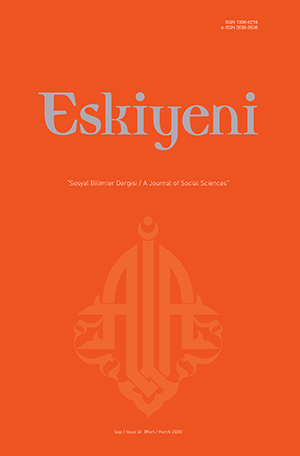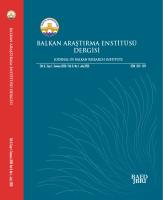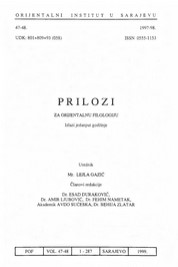Author(s): Nevzat Yiğit / Language(s): Turkish
Issue: 40/2020
In this study, the emergence of the Stretchers’ Quarry established in Scutari (Üsküdar), the change it has undergone in the historical process, the outbuildings of the quarry, the money foundations connected to the quarry and their functioning have been tried to be handled mostly in the light of the 18th century Ottoman Judges’s registers and archive records. In connection with the subject, previous studies have been examined and evaluated within the framework of documents. First of all, it should be noted that the tradition of hunting was an action made to meet the food and clothing needs of human beings in the historical process, but over time, it became an organi-zation for monarchs and state administrators to prepare for war with the enemy and sometimes for entertainment. Lethal and wounding tools to catch game animals, beside the falcon, bazzard, sparrowhawkand, goshawk, animals such as greyhound and hound were also used.Units named “chief of hunting” (Shikar Agha) were created in the Ottoman palace and the mili-tary organization, which were dealing with the care of animals used in hunting. The Stretchers’ Quarry, which is the subject of this study, is one of the units in question. Quarry was established in Scutari Garden, which belongs to the Palace in Scutari. The fact that Scutari was preferred as the location can be explained by the location of this place. Because the wide area extending from Scutari and Beykoz to Şile is allocated to the palace as hunting grounds. Scutari, one of the three important provinces of the state on the Anatolian side, is a region equipped with many instituti-ons. Although there is no exact information about the foundation date of the quarry, it is tho-ught that it was built in the same period as Scutari Garden, that is, after 1560’s. The quarry’s emp-loyees were called as tazidji, and those who were at the head were called tazidji corps In addition, since they are affiliated with Bostancıbaşı, the proportion of “bostanjî” (corps) has been added to the end of the employees’ names. “Tazıcıbaşı”, who are selected from people who have a certain status in the society, are responsible for the organziation of the quarry. They had additional duties such as protecting the forests, trees allocated for hunting and preventing anyone from hunting there. In the historical course, it is seen that during the times of extraordinary events, the tazidji and tazidji corps were given various duties to ensure the public order of the city. As it is understood from the records, a part of the financing of the quarry was provided by the income obtained from the foundation properties located around Scutari. Apart from Scutari, there were vineyards devoted to the quarry. Money Waqf, which have become an important part of the Ottoman economic life, also served as a source of financing for the Stretchers’ quarry. The administration of these foundations was undertaken by quarry workers nicknamed bostanî. The money foundations established here played an important role in meeting the needs of not only the quarry personnel but also the masjid in the outbuilding. According to the documents that have survived to date, it has been determined that money foundations are borrowed through one of the operating forms, the mortgage (lease). When the debt records in the court registers in the first quarter of the 18th century are examined, it is seen that Muslims borrow from the money foundations belonging to the palace gardens in the vicinity, and the non-Muslims living in Scuta-ri mostly prefer the foundations of the Stretchers’ Quarry.The quarry’s location which was built on the Karaca Ahmed side of today’s Selimiye barracks included the shelters of the rescuers, the masjid where the quarry’s staff pray, kitchen, barns for greyhounds, the Fountain of Stretchers’, and a tranining area for the archers. The masjid, built in two floors, was rebuilt in the 16th century because it was devastated over time. After the const-ruction of Selimiye Barracks in the 19th century, the masjid disappeared, therefore, not much information could be identified about it.Greyhounds barn is among the most important parts of the quarry. Greyhound has an important place in Turkish hunting culture. The Turks have been familiar with this animal since Central Asia. As a matter of fact, a greyhound called Turkish hound is mentioned in the documents. The ho-unds needed for the Stretchers’ quarry were primarily supplied from Scutari, Kocaeli. If needed, hound was also provided from nearby places such as Bolu and Hüdavendigar. In the time of IV. Mehmed, also known as Hunter Mehmed, hounds were brought from many places to the hunting areas where the sultan was located. According to the information in the archive records, flour was sent from Unkapanı to feed the hounds left in the barn, and the cost was collected from the treasury. The barn, which had existed for many years, was destroyed during the construction of the Selimiye Barracks, and the hounds were transferred to other places. After III. Selim was remo-ved from the throne, the barn was revived. With the abolition of the Janissary in 1826, the Stretc-hers’ Quarry and the stables barn ceased to be needed. According to the records, this place was allocated to horses since 1850. One of the places mentioned together with the Stretchers’ Quarry is the training area of the arc-her. There was an range point for the training of archers, which had a very important place in the classical period wars. According to the record written in 1705, this range point became disfuncti-onal about thirty years ago (1675), and Scutari archers demanded that this place be revived. The only outbuilding we have of the Stretchers’ Quarry today is the Stretchers’ Fountain. This fountain is located in the parking lot of Selimiye Petty Office Club to the right of the road from Scutari to Haydarpaşa. There is the Hasib Pasha Fountain just across the Stretchers’ Fountain. It is said that the Stretchers' Fountain was built by Mimar Sinan. However, in the inscriptions on the fountain, there are statements about the horses placed here after 1850. In the late 1800s and early 1900s, the water sewers around the fountain were repaired, landscaping was made by laying the sidewalk. The fountain was restored in 2019 with the efforts of the 1st Army Command, thus maintaining the historical memory.As a result, the Stretchers’ Quarry, which was built in the second half of the 16th century, continued its existence in Scutari for nearly three centuries. Due to its presence in Scutari, it has affec-ted the political and socio-economic life of this place in many ways. The quarry, 1826, with the removal of the Janissaries and a new management approach, it lost its function.
More...













